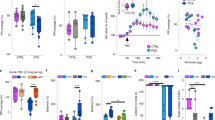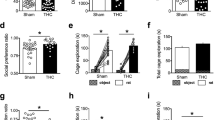Abstract
The exposure of pregnant rats to Δ9-tetrahydrocannabinol (Δ9-THC), the main psychoactive constituent ofCannabis sativa, during the perinatal period affects the gene expression and the activity of tyrosine hydroxylase (TH) in the brains of their offspring at peripubertal and adult ages. In the present work we explored whether these effects also appear during fetal and early neonatal periods, when TH expression plays an important role in neural development. To this end, the mRNA amounts for TH and the amounts and activity of this enzyme, in addition to catecholamine (CA) contents, were analyzed in the brain of fetuses at different gestational days (GD) and of newborns at two postnatal ages, which had been daily exposed to Δ9-THC or vehicle from d 5 of gestation. Results were as follows. The exposure to Δ9-THC markedly affected the expression of the TH gene in the brain of fetuses at GD 14. Thus, the amounts of its mRNA at this age were higher in Δ9-THC-exposed fetuses than in controls. This corresponded with a marked rise in the amounts of TH protein and in the activity of this enzyme at this age. Normalization was found in these parameters at GD16. However, a marked sexual dimorphism in the response of TH gene to cannabinoid exposure appeared from GD18 and was particularly evident at GD21, when TH-mRNA amounts increased in developing female brains, but decreased in developing male brains exposed to Δ9-THC, effects that were mostly prolonged to early postnatal ages. However, these changes did not correspond always with parallel changes in the amounts and activity of TH and in CA contents, as occurred in GD14, suggesting that Δ9-THC would not be affecting the basal capability to synthesize CAs in TH-containing neurons, but would affect the responsiveness of TH gene. We found only a marked increase in the production ofl-3,4-dihydroxyphenylacetic acid, the main intraneuronal dopamine metabolite, in female newborns exposed to Δ9-THC. Collectively, our results support the belief that the perinatal exposure to Δ9-THC affects the expression of the TH gene and, sometimes, the activity of this enzyme in brain catecholaminergic neurons in certain critical periods of fetal and early neonatal brain development. These results support the notion that cannabinoids are able to affect the gene expression of specific key proteins for catecholaminergic development, and that these alterations might be the origin of important long-term neurobehavioral effects caused by perinatal cannabinoid exposure at peripubertal and adult ages.
Similar content being viewed by others
References
Bonnin A., de Miguel R., Rodriguez-Manzaneque J. C., Fernandez-Ruiz J. J., Santos A., and Ramos J. A. (1994) Changes in tyrosine hydroxylase gene expression in mesencephalic catecholaminergic neurons of immature and adult male rats perinatally exposed to cannabinoids.Dev. Brain Res. 81, 147–150.
Bonnin A., de Miguel R., Hernandez M. L., Ramos J. A., and Fernandez-Ruiz J. J. (1995) The prenatal exposure to Δ9-tetrahydrocannabinol affects the gene expression and the activity of tyrosine hydroxylase during early brain development.Life Sci. 56, 2177–2184.
Chomczynski P. and Sacchi N. (1986) Single-step method of RNA isolation by acid guanidinium thiocyanate-phenol-chloroform extraction.Anal. Biochem. 162, 156–159.
Coulon J. F., Faucon-Biguet N., Cavoy A., Delacour J., Mallet J., and David J. C. (1990) Gene expression of tyrosine hydroxylase in the developing fetal brain.J. Neurochem. 55, 1412–1417.
Fernández-Ruiz J. J., Rodriguez de Fonseca F., Navarro M., and Ramos J. A. (1992) Maternal cannabinoid exposure and brain development: changes in the ontogeny of dopaminergic neurons, inMarihuana/Cannabinoids: Neurobiology and Neurophysiology (Murphy L. L. and Bartke A., eds.), CRC, Boca Raton, FL, pp. 119–164.
Fernández-Ruiz J. J., Bonnin A., Cebeira M., and Ramos J. A. (1994) Ontogenic and adult changes in the activity of hypothalamic and extrahypothalamic dopaminergic neurons after perinatal cannabinoid exposure, inStrategies for Studying Brain Disorders, vol. 1 (Palomo T. and Archer T., eds.), Farrand, London, UK, pp. 357–390.
Fernández-Ruiz J. J., Bonnin A., de Miguel R., Castro J. G., and Ramos J. A. (1996) Perinatal exposure to marihuana or to its main psychoactive constituent, Δ9-tetrahydrocannabinol, affects the development of brain dopaminergic neurons, inProceedings of the International Conference on Drugs of Abuse—Recent Advances in Clinical and Experimental Research (Tavares M. A. and Ali S. F., eds.), Arquivos de Medicina, Porto, Portugal, in press.
Garcia L., Castro J. G., Bonnin A., de Miguel R., Ramos J. A., and Fernández-Ruiz J. J. (1996) Exposure to psychoactive compounds of marihuana during perinatal development alters the responsiveness of midbrain dopaminergic neurons in adulthood to drugs which deplete dopamine stores and induce tyrosine hydroxylase gene expression, inProceedings of the International Conference on Drugs of Abuse—Recent Advances in Clinical and Experimental Research (Tavares M. A. and Ali S. F., eds.), Arquivos de Medicina, Porto, Portugal, in press.
Grima B., Lamoroux A., Boni C., Julien J. F., Javoy-Agid F., and Mallet J. (1987) A single human gene encoding multiple tyrosine hydroxylases with different predicted functional characteristics.Nature 326, 707–711.
Herkenham M., Lynn A. B., de Costa B. R., and Richfield E. K. (1991) Neuronal localization of cannabinoid receptors in the basal ganglia of the rat.Brain Res. 547, 267–274.
Herregodts P., Velkeniers B., Ebinger G., Michotte Y., Vanhaelst L., and Hooghe-Peters E. (1990) Development of monoaminergic neurotransmitters in fetal and postnatal rat brain: analysis by HPLC with electrochemical detection.J. Neurochem. 55, 774–779.
Howlett A. C., Bidaut-Russell M., Devane W. A., Melvin L. S., Johnson M. R., and Herkenham M. (1990) The cannabinoid receptor: biochemical, anatomical and behavioral characterization.TINS 13, 420–423.
Insel T. R. (1995) The development of the brain and behavior, inPsychopharmacology: The Fourth Generation of Progress (Bloom F. E. and Kupfer D. J., eds.), Raven, New York, pp. 683–694.
Labatut R., Buda M., and Bézod A. (1988) Long-term changes in rat brain tyrosine hydroxylase following reserpine treatment: a quantitative immunochemical analysis.J. Neurochem. 50, 1375–1380.
McLaughlin C. R. and Abood M. E. (1993) Developmental expression of cannabinoid receptor mRNA.Dev. Brain Res. 76, 75–78.
McLaughlin C. R., Martin B. R., Compton D. R., and Abood M. E. (1994) Cannabinoid receptors in developing rats: detection of mRNA and receptor binding.Drug Alcohol Depend. 36, 27–31.
Nagatsu T., Oka K., and Kato T. (1979) Highly sensitive assay for tyrosine hydroxylase activity by high performance liquid chromatography.J. Chromatogr. 163, 247–252.
Navarro M., Rodríguez de Fonseca F., Hernández M. L., Ramos J. A., and Fernández-Ruiz J. J. (1994) Motor behavior and nigrostriatal dopaminergic activity in adult rats perinatally exposed to cannabinoids.Pharmacol. Biochem. Behav. 47, 47–58.
Navarro M., de Miguel R., Rodríguez de Fonseca F., Ramos J. A., and Fernández-Ruiz J. J. (1996) Perinatal cannabinoid exposure modifies the sociosexual approach behavior and the mesolimbic dopaminergic activity in adult male rats.Behav. Brain Res. 75, 91–98.
Rinaldi-Carmona M., Barth F., Heaulme M., Shire D., Calandra B., Congy C., Martinez S., Maruani J., Néliat G., Caput D., Ferrara P., Soubrié P., Brelière J. C., and Le Fur G. (1994) SR 141716A, a potent and selective antagonist of the brain cannabinoid receptor.FEBS Lett. 350, 240–244.
Rodríguez de Fonseca F., Cebeira M., Hernández M. L., Ramos J. A., and Fernández-Ruiz J. J. (1990) Changes in brain dopaminergic indices induced by perinatal exposure to cannabinoids in rats.Dev. Brain Res. 51, 237–240.
Rodríguez de Fonseca F., Cebeira M., Fernández-Ruiz J. J., Navarro M., and Ramos J. A. (1991) Effects of pre- and perinatal exposure to hashish extracts on the ontogeny of brain dopaminergic neurons.Neuroscience 43, 713–723.
Rodríguez de Fonseca F., Hernández M. L., de Miguel R., Fernández-Ruiz J. J., and Ramos J. A. (1992) Early changes in the development of dopaminergic neurotransmission after maternal exposure to cannabinoids.Pharmacol. Biochem. Behav. 41, 469–474.
Rodríguez de Fonseca F., Ramos J. A., Bonnin A., and Fernández-Ruiz J. J. (1993) Presence of cannabinoid binding sites in the brain from early postnatal ages.Neuroreport 4, 135–138.
Specht L. A., Pickel W. M., Jooh T. H., and Reis D. J. (1981) Light microscopic immunocytochemical localization of tyrosine hydroxylase in prenatal rat brain. I. Early ontogeny.J. Comp. Neurol. 199, 233–245.
Walters D. E. and Carr L. A. (1986) Changes in brain catecholamine mechanisms following perinatal exposure to marihuana.Pharmacol. Biochem. Behav. 25, 763–768.
Author information
Authors and Affiliations
Additional information
Part of this work has been previously presented in abstract form and published in the Proceedings of the International Cannabis Research Society (July 21–23, 1994, L’Esterel, Quebec, Canada).
Rights and permissions
About this article
Cite this article
Bonnin, A., de Miguel, R., Castro, J.G. et al. Effects of perinatal exposure to Δ9-tetrahydrocannabinol on the fetal and early postnatal development of tyrosine hydroxylase-containing neurons in rat brain. J Mol Neurosci 7, 291–308 (1996). https://doi.org/10.1007/BF02737066
Received:
Accepted:
Issue Date:
DOI: https://doi.org/10.1007/BF02737066




